You’re breathing recycled air right now, and you probably don’t realize how it’s affecting your health. That stuffy feeling in your home office or your child’s bedroom isn’t just discomfort—it’s your body responding to elevated CO2 levels that can impair your thinking, disrupt your sleep, and even weaken your immune system. Most homeowners have no idea their indoor air quality is silently undermining their family’s well-being, but there’s a simple way to take control.
What Is Carbon Dioxide and Why Does It Matter Indoors?

Carbon dioxide might seem like an invisible concern, but it’s quietly accumulating in your home every time you breathe. This colorless, odorless gas naturally exists outdoors at around 400 ppm, yet indoor air quality deteriorates rapidly when CO2 levels climb without proper ventilation.
You’re fundamentally creating a buildup of exhaled carbon dioxide that can’t escape efficiently in poorly ventilated spaces. When CO2 levels exceed 1,000 ppm, you’ll start experiencing health effects like headaches, fatigue, and reduced cognitive function.
Your concentration and decision-making abilities can drop by up to 50% in spaces with inadequate ventilation.
Understanding carbon dioxide’s impact on your indoor environment helps you recognize why monitoring becomes crucial for maintaining healthy, comfortable living spaces.
Health Effects of Elevated CO2 Concentrations in Living Spaces
When CO2 concentrations climb above 1,000 ppm in your living spaces, your body starts sending clear warning signals that shouldn’t be ignored.
Your body doesn’t lie – when CO2 hits 1,000 ppm, those drowsiness and headache warnings demand immediate attention.
You’ll experience drowsiness, headaches, and impaired cognitive function that directly impacts your productivity. These elevated CO2 concentrations signal poor ventilation and compromised indoor air quality.
The health effects worsen as levels increase. Between 2,000-5,000 ppm, you’ll face dizziness, shortness of breath, and confusion.
Your decision-making abilities decline by 25% at 1,400 ppm, while strategic thinking drops 50% at considerably higher levels. High CO2 also correlates with increased volatile organic compounds, potentially triggering respiratory problems and allergies.
You should maintain levels below 800 ppm for ideal health and cognitive performance in your home.
How CO2 Levels Impact Cognitive Performance and Productivity
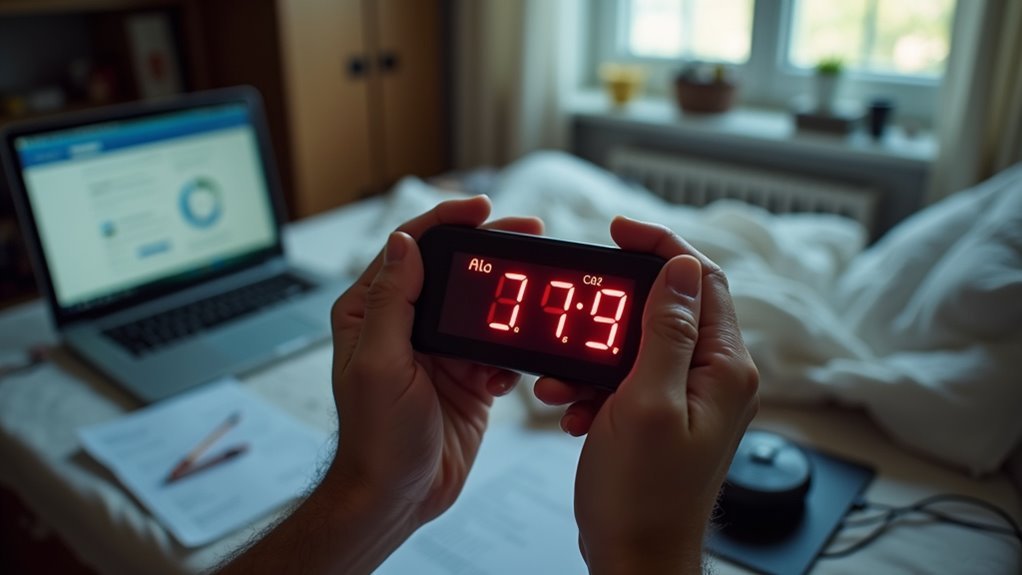
When CO2 levels in your home climb above 1,000 ppm, you’ll notice your brain doesn’t work as sharply as it should.
Your decision-making abilities can drop by 25% at concentrations above 1,400 ppm, while strategic thinking plummets by half.
This cognitive decline directly translates to reduced productivity, whether you’re working from home, studying, or handling daily tasks.
Brain Function Decline
Although you mightn’t immediately notice the effects, elevated CO2 levels in your home can dramatically impair your brain’s ability to function at its peak.
When indoor CO2 concentrations exceed 1,000 ppm, you’ll experience drowsiness and decreased concentration that directly undermines your cognitive performance. At 1,400 ppm, your decision-making skills drop by 25% while strategic thinking plummets by 50%.
If levels reach 1,800 ppm, your focus and task performance suffer notably. Beyond 2,000 ppm, you’ll face severe attention deficits and energy crashes. Continuous exposure leads to chronic fatigue and persistent cognitive decline.
Proper air quality management through effective ventilation systems isn’t optional—it’s essential for maintaining your mental sharpness and productivity.
Decision Making Impairment
The cognitive decline you experience from poor indoor air quality strikes your decision-making abilities with surprising precision. When elevated CO2 levels reach 1,400 ppm in your home, you’ll face a devastating 25% drop in decision-making skills that directly undermines your cognitive performance.
Your strategic thinking becomes even more compromised, plummeting by up to 50% as concentrations climb higher.
Even moderate levels between 1,000-2,000 ppm quietly sabotage your productivity through drowsiness and reduced attention spans.
You can’t afford to ignore how poor air quality affects your daily choices, from simple household decisions to complex problem-solving tasks.
Workplace Performance Drops
While you might associate workplace productivity issues with distractions or poor management, rising CO2 levels silently devastate your professional performance in ways you can’t immediately detect. When you monitor CO2 levels, you’ll discover that high levels of CO2 directly correlate with decreased cognitive function and increased drowsiness.
| CO2 Level (ppm) | Cognitive Impact | Productivity Effect |
|---|---|---|
| Below 500 | Ideal performance | Up to 60% increase |
| 1000-1400 | Mild impairment | 25% decision decline |
| Above 1400 | Severe decline | 50% strategic thinking loss |
Poor air quality doesn’t just affect your thinking—it increases absenteeism and reduces motivation. Indoor CO2 levels above 1000 ppm create fatigue that undermines your professional success, making continuous monitoring essential for maintaining peak workplace performance.
The Connection Between CO2 Monitoring and Virus Prevention
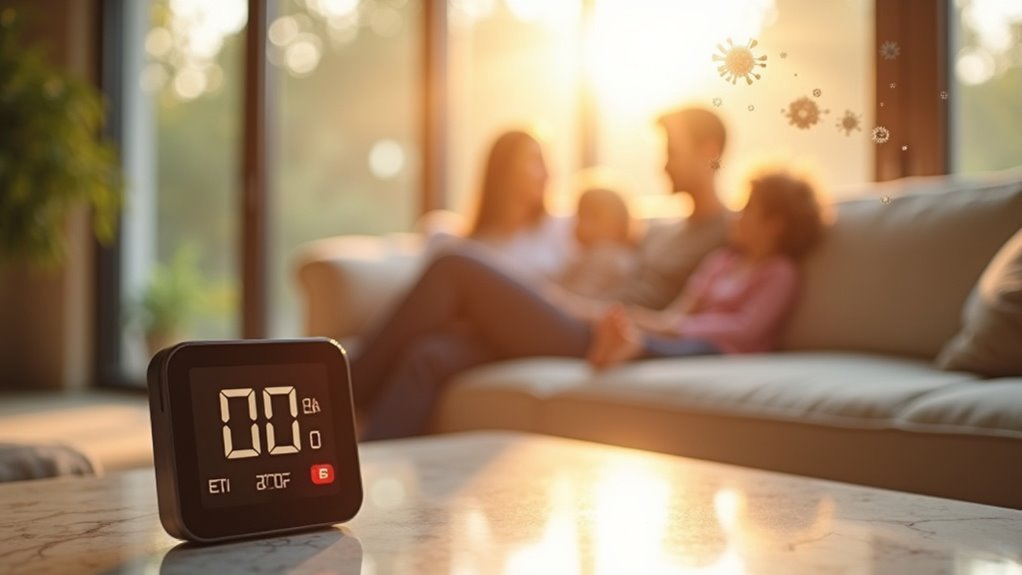
You can use CO2 levels as a reliable indicator of your home’s ventilation quality, helping you identify when fresh air circulation needs improvement.
When CO2 concentrations rise above 800 ppm, you’re also seeing increased airborne particles that can carry viruses like COVID-19 throughout your indoor spaces.
Ventilation Quality Indicators
Carbon dioxide monitors function as powerful early warning systems for detecting poor ventilation that can harbor dangerous viral particles in your home. These devices provide real-time feedback on your indoor air quality, helping you identify when fresh air exchange becomes insufficient. When monitoring CO2 levels consistently, you’ll notice patterns that directly correlate with ventilation quality throughout different areas of your house.
| CO2 Level (ppm) | Ventilation Quality | Airborne Virus Risk |
|---|---|---|
| Below 800 | Excellent | Low |
| 800-1000 | Adequate | Moderate |
| Above 1000 | Poor | High |
Understanding these indicators empowers you to take immediate action when readings spike above safe thresholds. You can open windows, adjust HVAC settings, or use fans to improve air circulation before harmful concentrations develop.
Airborne Particle Correlation
Because viruses and CO2 follow similar airborne dispersion patterns, your carbon dioxide monitor serves as an indirect but reliable indicator of viral particle concentrations in your home.
When CO2 levels rise above 800 ppm, you’re likely breathing recycled air that could contain airborne viruses from infected individuals. Well-ventilated spaces naturally dilute both CO2 and viral particles through fresh air exchange, making CO2 monitors essential tools for maintaining healthy indoor air quality.
Your monitor acts as an early warning system, alerting you when ventilation becomes inadequate and viral transmission risk increases.
- Fresh air dilution: Lower CO2 readings indicate better air turnover, reducing virus concentration
- Real-time assessment: Instant feedback helps you adjust ventilation before dangerous accumulation occurs
- Prevention strategy: Proactive monitoring prevents high-risk indoor conditions
Transmission Risk Reduction
Three key factors determine your home’s virus transmission risk: air circulation, occupancy levels, and ventilation effectiveness.
By monitoring CO2 levels, you’re fundamentally tracking how well your space exchanges fresh air with stale, potentially contaminated air. When CO2 concentrations climb above 800 ppm, you’re likely sharing more recycled air with others, increasing transmission risks considerably.
Maintaining CO2 levels below 700 ppm creates an environment where airborne viruses struggle to accumulate. Your ventilation system works more effectively at these lower concentrations, continuously diluting viral particles before they reach dangerous levels.
This proactive approach to indoor air quality gives you measurable control over your family’s health. You’ll know immediately when rooms need better airflow, allowing quick adjustments that greatly reduce infection probability.
Identifying Poor Ventilation Through CO2 Measurements
When indoor air feels stuffy or occupants experience unexplained fatigue, CO2 measurements can reveal whether poor ventilation is the culprit. CO2 levels exceeding 1,000 ppm indicate inadequate air exchange and potential buildup of indoor pollutants.
Using CO2 monitors, you can identify spaces where air quality deteriorates rapidly. Studies show closed spaces can reach 1,380 ppm within hours without proper ventilation. When concentrations exceed 1,800 ppm, you’ll likely experience headaches, dizziness, and reduced cognitive function.
Regular monitoring reveals air quality trends, enabling proactive ventilation improvements.
- Track CO2 patterns throughout different times and activities to identify peak exposure periods
- Maintain levels below 800 ppm for ideal health and reduced risk of respiratory issues
- Use real-time data to adjust ventilation systems and window opening schedules effectively
Optimal CO2 Levels for Different Areas of Your Home
Different rooms in your home require specific CO2 thresholds to maintain healthy air quality and optimal comfort levels.
Your living rooms and bedrooms should maintain ideal CO2 levels between 400-800 ppm for maximum comfort.
In kitchens, you’ll notice indoor levels can spike to 1,100 ppm during cooking, making proper ventilation essential.
Home offices need monitoring to stay below 1,000 ppm since higher concentrations reduce cognitive function and productivity.
Basements and utility rooms often struggle with poor airflow, requiring careful monitoring to prevent health issues from elevated readings.
Children’s bedrooms deserve special attention – keeping CO2 below 1,000 ppm protects their cognitive development and sleep quality.
Regular monitoring across these different areas guarantees you’re maintaining safe, comfortable environments throughout your entire home.
Energy Efficiency Benefits of Smart CO2 Monitoring Systems
Smart CO2 monitoring systems deliver considerable energy savings while maintaining the best air quality levels you’ve established for each room.
These systems enhance your HVAC efficiency by using demand-controlled ventilation that adjusts airflow based on real-time carbon dioxide levels. You’ll only use energy when it’s actually needed, reducing unnecessary heating and cooling costs.
Your smart CO2 monitoring systems improve indoor air quality while preventing energy waste through automated alerts and adjustments. When CO2 levels drop below ideal thresholds, the system reduces ventilation rates, cutting utility expenses markedly.
- Demand-controlled ventilation: Airflow adjusts automatically based on occupancy and CO2 detection
- Real-time enhancement: HVAC systems respond instantly to changing air quality conditions
- Cognitive performance boost: Lower CO2 levels improve productivity while reducing lighting and heating needs
Types of Home CO2 Monitors and Their Features
While building upon your smart CO2 monitoring foundation, you’ll find three primary categories of home CO2 monitors that cater to different monitoring needs and installation preferences.
Handheld units offer portability for spot-checking different rooms, while desktop models like the TIM10 provide reliable accuracy within ±50 ppm at under $100. Permanently installed systems deliver the most thorough solution for continuous monitoring.
Advanced features distinguish quality monitors from basic models. Look for safety alarms following OSHA guidelines, large LCD displays for easy reading, and real-time data updates.
The TEKTELIC BREEZE-D exemplifies premium functionality with 10-year battery life and motion detection. These home CO2 monitors help you effectively monitor carbon dioxide levels, track trends over time, and maintain ideal indoor air quality for enhanced health and comfort.
Where to Install CO2 Sensors Throughout Your House
Where you position your CO2 sensors directly impacts their accuracy and effectiveness in protecting your family’s health.
Install sensors at head height in living rooms and bedrooms where you spend most time to accurately monitor indoor air quality. In kitchens, place them at least 12 inches off the floor to avoid cooking-related interference.
Position sensors away from windows, doors, and HVAC vents to prevent outdoor air from skewing readings.
For thorough coverage, consider these strategic locations:
- High-occupancy areas – Multiple sensors in larger rooms guarantee you monitor levels throughout the entire space
- Near gas appliances – Kitchen stoves, water heaters, and furnaces can elevate CO2 concentrations
- Basement installations – Poor ventilation in lower levels requires careful monitoring for dangerous build-up
Understanding CO2 Monitor Readings and Alert Systems
How do you interpret the numbers flashing on your CO2 monitor’s display and know when to take action? CO2 monitors provide real-time readings that track your indoor air quality effectively.
When carbon dioxide levels reach 1,000 ppm, alert systems trigger notifications prompting immediate ventilation actions to maintain safety.
At 1,000 ppm CO2, your monitor’s alert system activates, signaling the urgent need for immediate ventilation to protect indoor air safety.
Most monitors feature visual and audible alarms that deliver immediate feedback, preventing health issues from elevated CO2 concentrations. You’ll receive clear signals when air quality deteriorates, allowing prompt responses.
Regular readings help you identify air quality trends over time, making it easier to assess your ventilation system’s effectiveness.
Advanced monitors can integrate with smart home systems, automatically adjusting HVAC settings based on current concentrations for peak indoor air management.
How CO2 Monitoring Improves Sleep Quality in Bedrooms
You’ll discover that monitoring CO2 levels in your bedroom directly impacts how well you sleep each night.
When CO2 concentrations rise above 1000 ppm, you’re likely to experience restless sleep, morning grogginess, and reduced mental sharpness the next day.
Bedroom CO2 Sleep Connection
Because your bedroom’s air quality directly impacts your sleep cycles, monitoring CO2 levels can transform restless nights into restorative rest.
When CO2 concentrations exceed 1,000 ppm, you’ll experience sleep disturbances and increased wakefulness. High CO2 concentrations above 1,400 ppm slash your decision-making skills by 25% the next morning, leaving you mentally foggy and unable to perform at your best.
Monitoring CO2 helps you maintain ideal levels below 800 ppm through improved ventilation strategies. You’ll wake up feeling refreshed instead of battling headaches, fatigue, and poor concentration that plague poorly ventilated bedrooms.
- Track CO2 patterns to identify when your bedroom needs fresh air circulation
- Implement targeted ventilation strategies before sleep quality deteriorates
- Prevent cognitive impairment by maintaining consistently healthy air quality
Optimal Nighttime Air Quality
Smart CO2 monitors transform your bedroom into a sleep sanctuary by maintaining the sweet spot of 400-800 ppm throughout the night.
When CO2 levels climb above 1000 ppm, you’ll experience increased drowsiness and disrupted sleep patterns that leave you groggy. Without proper monitoring, concentrations often exceed 1400 ppm overnight, impairing your cognitive function and making morning wake-ups difficult.
Real-time alerts from smart monitors enable immediate ventilation adjustments, ensuring fresh air circulation when you need it most.
You’ll avoid the headaches and fatigue that come with elevated CO2 concentrations. By continuously tracking ideal CO2 levels, you’re creating conditions for deeper, more restorative sleep.
This proactive approach to air quality monitoring directly improves your sleep quality and enhances daytime alertness.
Ventilation for Better Rest
When CO2 levels spike above 1000 ppm in your bedroom, your body struggles to achieve the deep sleep cycles essential for mental and physical recovery. Elevated levels above 1400 ppm impair cognitive functions and increase drowsiness, making proper ventilation vital for restful nights.
CO2 monitoring provides real-time insights into your indoor air quality, helping you maintain ideal conditions below 800 ppm for enhanced sleep quality. Continuous monitoring prompts timely ventilation adjustments, ensuring fresh air circulation that reduces morning headaches and fatigue.
You’ll experience deeper, uninterrupted rest when your sleeping environment maintains proper airflow and lower CO2 concentrations.
- Real-time alerts enable immediate ventilation responses before air quality deteriorates
- Consistent monitoring creates long-term sleep environment idealization patterns
- Data-driven adjustments eliminate guesswork in maintaining perfect bedroom conditions
Protecting Children and Elderly Family Members From High CO2
Although adults might barely notice subtle changes in air quality, children and elderly family members face markedly higher risks from elevated CO2 levels in your home. These vulnerable populations experience drowsiness and cognitive decline at lower concentrations than healthy adults.
| CO2 Level (ppm) | Health Effects |
|---|---|
| Above 1,000 | Drowsiness, reduced cognitive function |
| Above 2,000 | Headaches, dizziness, respiratory problems |
| Below 800 | Recommended safe level |
| During cooking | Requires immediate ventilation |
Monitoring CO2 levels becomes essential when protecting children and elderly relatives. You’ll need proper ventilation during high-activity periods like cooking or when multiple people occupy confined spaces. Regular monitoring alerts you to inadequate indoor air quality, enabling timely interventions that safeguard your family’s most vulnerable members from high levels of CO2.
Cost Savings Through Demand-Controlled Home Ventilation
Beyond health benefits, CO2 monitoring delivers substantial cost savings by enabling demand-controlled ventilation that adjusts airflow based on actual occupancy rather than running continuously.
You’ll reduce energy consumption by 20-30% when your ventilation systems operate only when needed, maintaining ideal indoor air quality without waste.
By keeping CO2 levels between 400-800 ppm, you’ll prevent over-ventilation during low-activity periods like nighttime or when you’re away.
This intelligent approach eliminates unnecessary heating and cooling costs while ensuring comfort.
Key savings opportunities:
- Smart timing: Reduce ventilation during unoccupied periods without compromising air quality
- Seasonal efficiency: Minimize energy loss by ventilating only when CO2 rises above acceptable thresholds
- Automated control: Let demand-controlled ventilation systems enhance airflow automatically, maximizing energy savings
Setting Up Automated Responses to CO2 Level Changes
You can transform your CO2 monitoring system from a passive observer into an active guardian by setting up automated responses that kick in when levels cross critical thresholds.
Start by integrating your smart CO2 monitors with your existing ventilation systems so they’ll automatically increase airflow when readings exceed 1,000 ppm.
Configure mobile alerts and program your HVAC system to respond intelligently to real-time CO2 data, creating a seamless defense against poor indoor air quality.
Smart Ventilation System Integration
When CO2 levels in your home consistently climb above comfortable thresholds, integrating smart ventilation systems with your CO2 monitors creates an automated defense against poor air quality.
These systems respond instantly when elevated CO2 levels exceed 1,000 ppm, triggering increased ventilation rates or activating air purifiers without your intervention. Automated responses enhance your HVAC operations based on real-time occupancy patterns, delivering energy savings while maintaining healthy indoor air quality.
Your smart CO2 monitors can send alerts when levels reach critical thresholds, prompting immediate action to prevent health issues.
- Real-time air quality management – Systems adjust automatically to maintain ideal breathing conditions
- Energy-efficient operations – Smart algorithms balance air quality needs with power consumption
- Proactive health protection – Prevents CO2 buildup before it impacts your well-being
Mobile Alert Configuration
Although smart ventilation systems provide automated responses, configuring mobile alert configurations guarantees you’ll receive immediate notifications wherever you’re when CO2 levels spike beyond safe limits.
Smart CO2 monitors offer customizable alert settings that send real-time notifications directly to your smartphone, ensuring you’re always informed about your indoor air quality status.
You can set specific thresholds, typically above 1000 ppm for initial warnings and 1500 ppm for critical alerts, preventing cognitive impairment and health risks.
These notifications enable prompt action, whether you’re opening windows, activating air purifiers, or adjusting HVAC settings remotely.
Integration with smart home systems allows automated responses to trigger simultaneously with mobile alerts, creating an all-encompassing air quality management system that protects your family’s health around the clock.
HVAC Automation Programming
Programming your HVAC system to automatically respond to CO2 level changes transforms passive monitoring into active air quality management.
You’ll enhance indoor air quality by configuring your system to adjust ventilation rates based on real-time CO2 measurements, keeping levels below 1,000 ppm for ideal health and cognitive function.
HVAC automation activates fresh air intake or exhaust fans when CO2 concentrations exceed safe limits, preventing headaches and fatigue.
You’ll achieve significant energy savings since the system operates only when necessary, rather than running continuously.
- Demand-controlled ventilation: Reduces airborne virus transmission risk during health crises
- Energy efficiency: Lowers costs by eliminating unnecessary constant ventilation
- Regular calibration: Guarantees accurate readings for consistent, productive indoor environments
Frequently Asked Questions
Why Would You Monitor CO2 Levels?
You’d monitor CO2 levels to protect your health, maintain cognitive function, and guarantee proper ventilation. High concentrations cause headaches and fatigue, while tracking helps optimize air quality and energy efficiency.
Why Is CO2 Monitoring Important?
You’ll protect your health by tracking CO2 levels, as concentrations above 1,000 ppm cause headaches and reduce cognitive function by 25%, while also indicating poor ventilation and increased pathogen risks.
What Causes CO2 to Be High in a House?
You’ll find high CO2 levels from inadequate ventilation, cooking activities, gas appliances, crowded spaces, and poorly functioning HVAC systems. Each person exhales CO2 daily, and unvented fireplaces worsen accumulation considerably.
What Does a CO2 Monitor Tell You?
A CO2 monitor tells you real-time carbon dioxide levels in your air, alerts you when they exceed safe thresholds, and helps you track air quality trends to maintain healthy indoor environments.

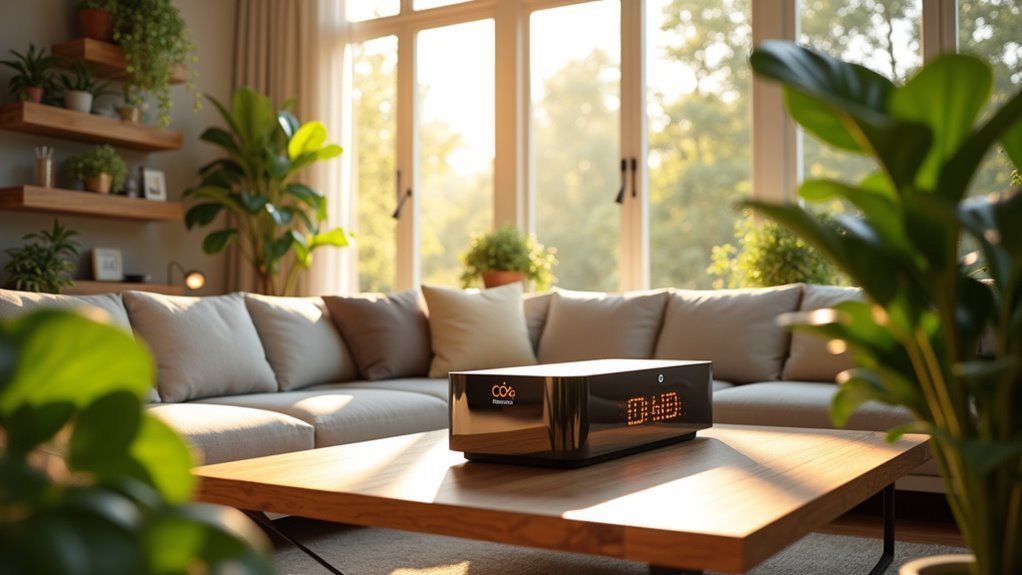
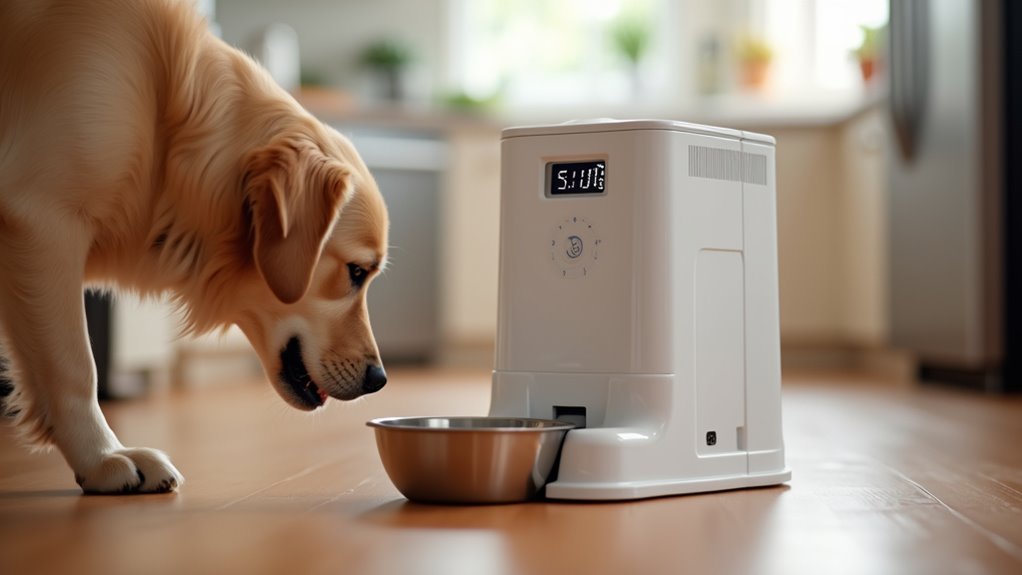
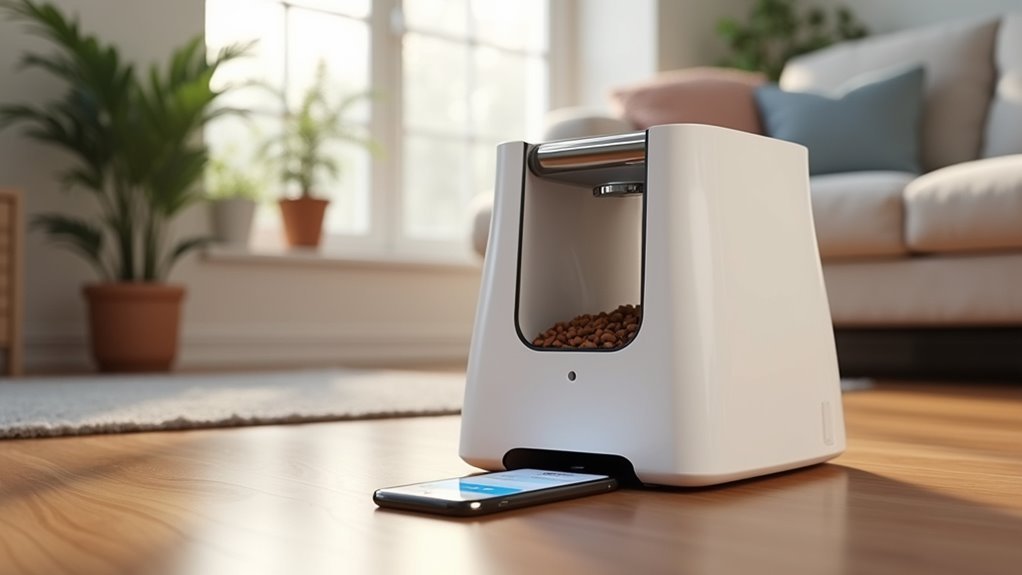

Leave a Reply